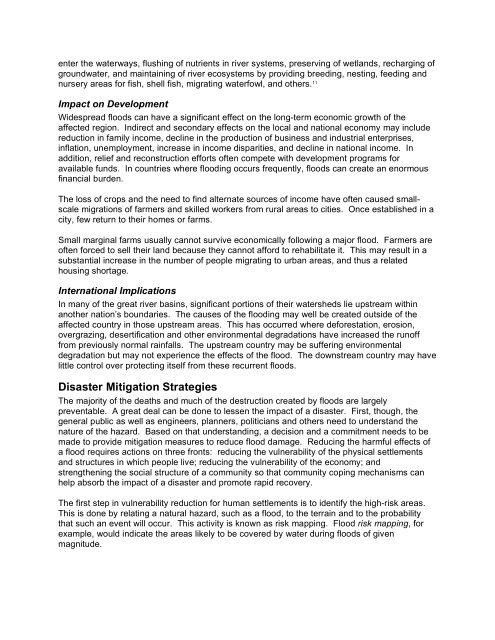Natural Hazards: Causes and Effects - Disaster Management Center ...
Natural Hazards: Causes and Effects - Disaster Management Center ...
Natural Hazards: Causes and Effects - Disaster Management Center ...
You also want an ePaper? Increase the reach of your titles
YUMPU automatically turns print PDFs into web optimized ePapers that Google loves.
enter the waterways, flushing of nutrients in river systems, preserving of wetl<strong>and</strong>s, recharging of<br />
groundwater, <strong>and</strong> maintaining of river ecosystems by providing breeding, nesting, feeding <strong>and</strong><br />
nursery areas for fish, shell fish, migrating waterfowl, <strong>and</strong> others. 11<br />
Impact on Development<br />
Widespread floods can have a significant effect on the long-term economic growth of the<br />
affected region. Indirect <strong>and</strong> secondary effects on the local <strong>and</strong> national economy may include<br />
reduction in family income, decline in the production of business <strong>and</strong> industrial enterprises,<br />
inflation, unemployment, increase in income disparities, <strong>and</strong> decline in national income. In<br />
addition, relief <strong>and</strong> reconstruction efforts often compete with development programs for<br />
available funds. In countries where flooding occurs frequently, floods can create an enormous<br />
financial burden.<br />
The loss of crops <strong>and</strong> the need to find alternate sources of income have often caused smallscale<br />
migrations of farmers <strong>and</strong> skilled workers from rural areas to cities. Once established in a<br />
city, few return to their homes or farms.<br />
Small marginal farms usually cannot survive economically following a major flood. Farmers are<br />
often forced to sell their l<strong>and</strong> because they cannot afford to rehabilitate it. This may result in a<br />
substantial increase in the number of people migrating to urban areas, <strong>and</strong> thus a related<br />
housing shortage.<br />
International Implications<br />
In many of the great river basins, significant portions of their watersheds lie upstream within<br />
another nation’s boundaries. The causes of the flooding may well be created outside of the<br />
affected country in those upstream areas. This has occurred where deforestation, erosion,<br />
overgrazing, desertification <strong>and</strong> other environmental degradations have increased the runoff<br />
from previously normal rainfalls. The upstream country may be suffering environmental<br />
degradation but may not experience the effects of the flood. The downstream country may have<br />
little control over protecting itself from these recurrent floods.<br />
<strong>Disaster</strong> Mitigation Strategies<br />
The majority of the deaths <strong>and</strong> much of the destruction created by floods are largely<br />
preventable. A great deal can be done to lessen the impact of a disaster. First, though, the<br />
general public as well as engineers, planners, politicians <strong>and</strong> others need to underst<strong>and</strong> the<br />
nature of the hazard. Based on that underst<strong>and</strong>ing, a decision <strong>and</strong> a commitment needs to be<br />
made to provide mitigation measures to reduce flood damage. Reducing the harmful effects of<br />
a flood requires actions on three fronts: reducing the vulnerability of the physical settlements<br />
<strong>and</strong> structures in which people live; reducing the vulnerability of the economy; <strong>and</strong><br />
strengthening the social structure of a community so that community coping mechanisms can<br />
help absorb the impact of a disaster <strong>and</strong> promote rapid recovery.<br />
The first step in vulnerability reduction for human settlements is to identify the high-risk areas.<br />
This is done by relating a natural hazard, such as a flood, to the terrain <strong>and</strong> to the probability<br />
that such an event will occur. This activity is known as risk mapping. Flood risk mapping, for<br />
example, would indicate the areas likely to be covered by water during floods of given<br />
magnitude.








